Review by Darren Griffin
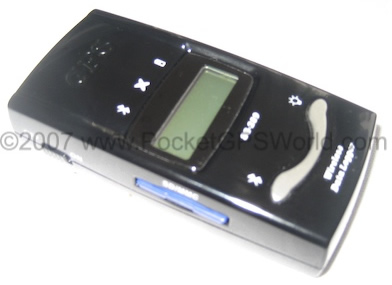
ZyCast SG-289 SiRFStarIII Bluetooth Receiver
Back in April I had the opportunity to review the ZyCast SG-288 Bluetooth GPS Receiver. This turned out to be an excellent unit with very fast acquisition times and the useful addition of a small backlit LCD display.
Following on from this ZyCast have now released its bigger brother the SG-289 which has the added bonus of datalogger functionality. For those unaware as to what exactly this is, basically the unit can record your journeys to a log file which can be replayed at a later date using various methods, the best known being Google Earth. It's also useful for geo-tagging whereby the log file position is matched to the time and date encoded when taking a digital picture. This allows you to add the exact latitude/longitude of where a photograph was taken to an image file.
If you have already seen the review of the SG-288 then you will be familiar with the form factor of the unit. The SG-289 differs only in being slightly longer to accommodate the addition of the SD card slot.
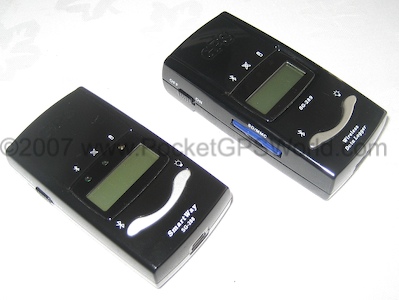
ZyCast's SG-288 & SG-289 Compared (SG-288 is below SG-289)
Once again, GPSForLess, the UK distributor and retailer for this product have provided us with a review sample and below are the results of my testing which took the SG-289 to Hong Kong and all the way back to its birthplace in Taiwan.
SiRFStarIII Chipset
The SiRFStarIII Chipset has been discussed in depth many times. Suffice to say that the majority receivers available today contain this chipset and it works superbly. There were until recently no competitors that could surpass it but GlobalLocate and MTK have now stepped up although SiRF is still an excellent performer.
Specification
|
|
Frequency
|
L1, 1575.42 MH |
C/A code
|
1.023 MHz chip rate |
Channels
|
20 channels all in view tracking |
Chipset
|
SiRFIII |
Datum
|
WGS-84 |
Accuracy
Position |
< 10 meters, 2D RMS
< 7 meters 2D RMS, WAAS corrected
1-5 meters, DGPS corrected |
Sensitivity
|
-159 dBm typical |
Reacquisition
Hot
Warm
Cold |
<0.1s
1s typical
38s typical
42s typical |
Power input
|
5.0 ü+/-5% VDC input. |
Battery
|
Rechargeable 1200mAH Li-ion battery |
GPS Protocol
|
GGA, GSA, GSV, RMC, 19200 baud rate, (GLL, VTG, and
ZDA optional) |
| Dimension |
93 x 46 x 23 mm |
| Weight |
<70 g (Battery & SD/MMC Card not included)
|
What's In The Box?
The box contains the ZyCast SG-289 Bluetooth Datalogger Receiver, a 1GB SD Card, Multi-Standard (110/240v) mains charger and 3 pin adapter, 12v Cigarette lighter adapter and USB cable. The use of USB for charging is great as you can use the chargers and USB cable to charge any other MiniUSB devices you may have. Also provided is a manual in Adobe format on CD.
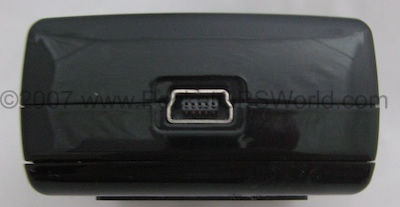
MiniUSB Charger Socket
The receiver itself is compact. Larger than some receivers but smaller than every datalogger I have come across to date. The SG-289 is large enough to operate and use easily and small enough to place in your pocket or hang on a lanyard (for which incidentally there is a small loop you can connect to).
At the bottom is the MiniUSB connector, to the side is the On/OFF switch, and on the rear is the battery panel under which lies a 1200mAh Lithium Ion battery pack.
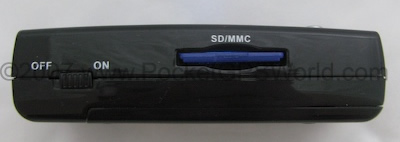
ZyCast SG-289 Side View showing ON/OFF Switch and SD/MMC Card Slot
In Use
On switching on the unit the display shows model name, firmware version, time, SD Card and battery status.

ZyCast SG-289 Startup Display
There are three LED lights above the LCD display and these are (from left to right), Bluetooth ON/OFF, GPS Fix and Power status.
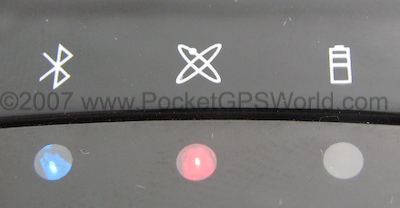
Below the display are two buttons. In normal use these control Bluetooth On/Off and Back light which is a cool blue!. However there are a number of user controllable options which can be configured using a menu system which is also accessed via these buttons.
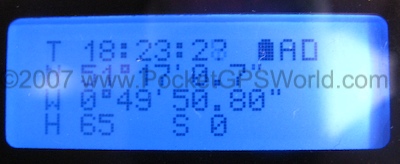
ZyCast SG-288 GPS Fix
Above you can see the display once a fix has been calculated. From top to bottom there is current GPS calculated time, Latitude, Longitude and on the bottom line Altitude and Speed. At top right are the battery status, datalogger mode (A=Auto in this example) and Memory-Card status (here the Icon indicates a Memory-Card is not present).
Bonding was a typically painless experience with ZyCast using the default 0000 passkey. My previous experiences with the SG-288 were very interesting as fresh out of the box that receiver got a fix within 5 seconds and warm starting the device it would lock within one or two seconds. I'm pleased to report that the SG-289 is no different in this area and also acquires satellite lock very quickly.
Once again I've had great fun trying to defeat the SG-289 in the same fashion as the 288. It too works buried deep inside the cupboard under my stairs and similarly hidden in the glove box of my car or under the passenger seat. When walking about it would maintain lock under the most arduous conditions and when finally defeated by walking into a building it would quickly re-aquire as soon as I stepped outside.
The configuration options allow you access to the following menus:
GPS Menu
- Time Offset (used to set to GMT or GMT+1 etc)
- Speed Alarm (you can set a maximum speed above which an audible alarm is triggered)
- Speed Units (mph / kph)
- Bluetooth ON at Startup or OFF
Datalogger Menu
- NMEA Options (used to choose which sentences you wish logged i.e. time, speed etc)
- Logging Interval
- Recorder Mode (You can specify a fixed time interval, auto which logs dependent on speed and user activated where a position is recorded only when you press a button
Data Logging
ZyCast's decision to use SD based memory on this unit is a master stroke. Traditionally datalogger's have used built-in memory which meant you were unable to upgrade the units capacity. Additionally it often mean extracting the data relied upon a manufacturer supplied utility and was as a result not always as simple as it could be. With the inclusion here of an SD slot, the memory can be easily upgraded with larger SD or MMC cards and accessing the log files is simplicity itself, just pop the SD card into a card reader and plug into your computer. The track logs are simple .txt files that can be copied off the card and imported into whichever program you choose to use.
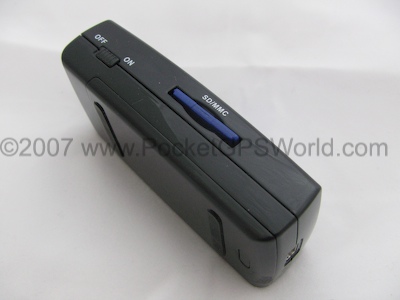
ZyCast SG-289 Side View showing SD Card Slot
On my travels through Hong Kong I used the SG-289 to track our journeys. Placed in my shirt pocket it had no trouble maintaining a fix and the battery gave a full days tracking without failing. I prefer Google Earth to display my tracks and use a website called GPS Visualizer to convert the .txt log files into Google's .kmz format.
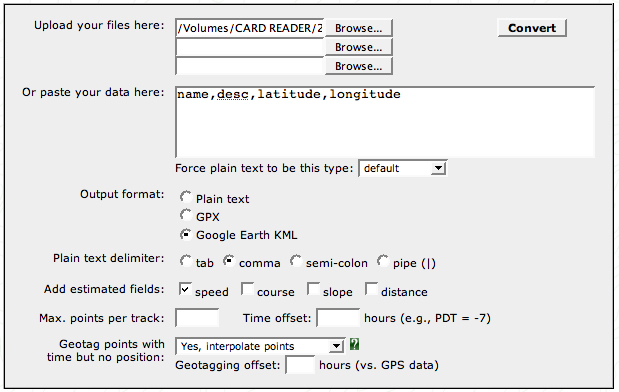
GPSVisualizer.com On-Line Conversion Tool
They have a very simple on-line conversion tool, all you do is browse to your log file, choose your defaults (in the case of the SG-289 all that you need to do is choose your output format, .kml for Google Earth) and click 'Convert'. The resulting .kmz file is then created and can be downloaded and opened in Google Earth.
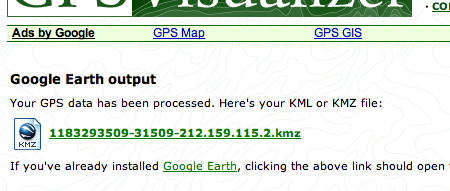
GPSVisualizer.com Output
The picture below is a track of our journey in the car that collected us from the airport. To the left of the picture is Hong Kong's new airport. Initially I had forgotten to turn on the SG-289 (it's a 12 hour flight and I wasn't entirely awake!) but remembered at about the point where the arrow indicates. You can see that despite having traveled nearly 6000 miles since its last fix it managed to achieve a lock within a mile of my switching it on. The track log begins at top right of the image (track in red).
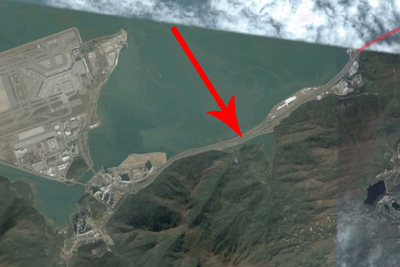
Arrival in Hong Kong
(Courtesy of Google Earth)
Below is the latter part of that journey, traveling into congested Kowloon with all the typical conditions which affect GPS, tunnels, tall buildings (urban canyons), narrow streets, multi path signals etc. None of these phased the SG-289 which maintained an accurate fix and the resulting log file was spot on accurate when overlaid in Google Earth.
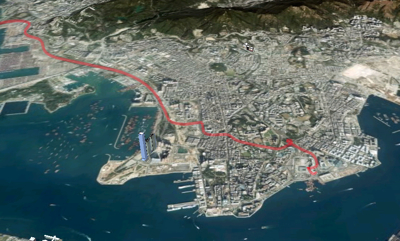
The journey from Hong Kong Airport to our hotel in Kowloon
(Courtesy of Google Earth)
The following day we headed across the harbour into Central and up Victoria Peak, as you can see below, once again the 289 performed well. If you look closely you can see a small 'hiccup' after we alighted the ferry (just to the right of TWO IFC the large skyscraper). Clearly on this occasion it had either lost signal or become confused by some multi-path signals but this was the only example I saw in use. I tested the battery duration and it finally stopped logging after nearly 12 hours which is in accordance with the manufacturers claims.
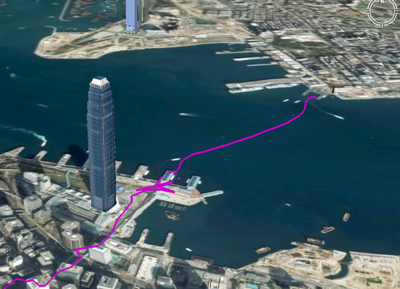
Traveling across Hong Kong Harbour on the Star Ferry and walking into Central
(Courtesy of Google Earth)
EGNOS/WAAS
The ZyCast SG-288 is EGNOS/WAAS capable.
Battery Life
I have mentioned the 12hour battery life before (the 1200mAh battery ran for close to 12 hours during tests with Bluetooth off but datalogging running) but a huge plus of this receiver (as it was with the SG-288) and an oft requested feature is the hardware ON/OFF switch. Some users are keen to install their Bluetooth GPS in a remote location in the vehicle, hidden under the rear parcel shelf for example. Many current receivers have 'Soft' ON/OFF switches which makes them unsuitable but with the SG-288, if it is supplied with an ignition controlled power feed then it will switch ON/OFF with the ignition if its power switch is left ON and the battery is removed. As this has datalogger functionality it could conceivably be pressed into use to covertly log a journey, I fancy trying this when I leave my car in the hands of BCP Parking next month, just to see where it goes and how gently they drive it!
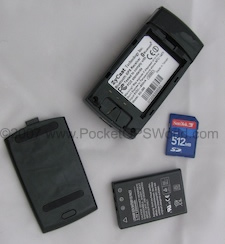
Bottom view with battery removed
Manual
To download and review the user manual click this link.
|